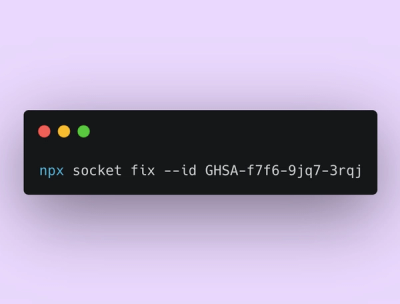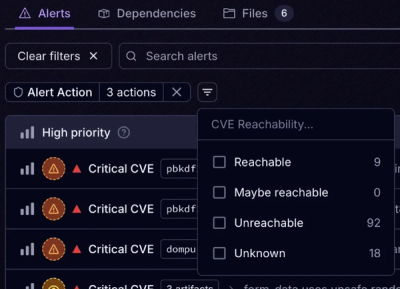
Product
Announcing Socket Fix 2.0
Socket Fix 2.0 brings targeted CVE remediation, smarter upgrade planning, and broader ecosystem support to help developers get to zero alerts.
tinygradient
Advanced tools
The tinygradient npm package is a lightweight library for creating and manipulating gradients. It allows you to generate gradients with multiple colors, interpolate colors, and convert gradients to different formats.
Creating a Gradient
This feature allows you to create a gradient by specifying an array of color stops. The example creates a gradient from red to green to blue.
const tinygradient = require('tinygradient');
const gradient = tinygradient(['#ff0000', '#00ff00', '#0000ff']);
console.log(gradient);Getting Colors from a Gradient
This feature allows you to get an array of colors from the gradient. The example gets 10 colors from the gradient.
const tinygradient = require('tinygradient');
const gradient = tinygradient(['#ff0000', '#00ff00', '#0000ff']);
const colors = gradient.rgb(10);
console.log(colors);Converting Gradient to CSS
This feature allows you to convert the gradient to a CSS gradient string. The example converts the gradient to a linear gradient going to the right.
const tinygradient = require('tinygradient');
const gradient = tinygradient(['#ff0000', '#00ff00', '#0000ff']);
const cssGradient = gradient.css('linear', 'to right');
console.log(cssGradient);Chroma.js is a powerful library for color manipulation and conversion. It supports a wide range of color spaces and provides functions for color interpolation, blending, and more. Compared to tinygradient, chroma-js offers more advanced color manipulation features but may be more complex to use for simple gradient tasks.
Gradient-color is a simple library for generating gradient colors. It allows you to create gradients with multiple colors and get interpolated colors from the gradient. Compared to tinygradient, gradient-color is more focused on generating color arrays and may lack some of the advanced features of tinygradient.
Color-gradient is a lightweight library for creating color gradients. It provides basic functionality for generating gradients and getting colors from the gradient. Compared to tinygradient, color-gradient is simpler and may be easier to use for basic gradient tasks but lacks some of the advanced features of tinygradient.
Easily generate color gradients with an unlimited number of color stops and steps.
$ npm install tinygradient
The gradient can be generated using RGB or HSV interpolation. HSV usually produces brighter colors.
The tinygradient constructor takes a list or an array of colors stops.
// using varargs
const gradient = tinygradient('red', 'green', 'blue');
// using array
const gradient = tinygradient([
'#ff0000',
'#00ff00',
'#0000ff'
]);
The colors are parsed with TinyColor, multiple formats are accepted.
const gradient = tinygradient([
tinycolor('#ff0000'), // tinycolor object
{r: 0, g: 255, b: 0}, // RGB object
{h: 240, s: 1, v: 1, a: 1}, // HSVa object
'rgb(120, 120, 0)', // RGB CSS string
'gold' // named color
]);
You can also specify the position of each color stop (between 0 and 1). If no position is specified, stops are distributed equidistantly.
const gradient = tinygradient([
{color: '#d8e0de', pos: 0},
{color: '#255B53', pos: 0.8},
{color: '#000000', pos: 1}
]);
Each method takes at least the number of desired steps.
The generated gradients might have one more step in certain conditions.
// RGB interpolation
const colorsRgb = gradient.rgb(9);

// HSV clockwise interpolation
const colorsHsv = gradient.hsv(9);

// HSV counter-clockwise interpolation
const colorsHsv = gradient.hsv(9, true);

There are also two methods which will automatically choose between clockwise and counter-clockwise.
// HSV interpolation using shortest arc between colors
const colorsHsv = gradient.hsv(9, 'short');
// HSV interpolation using longest arc between colors
const colorsHsv = gradient.hsv(9, 'long');
Each method returns an array of TinyColor objects, see available methods.
The css method will output a valid W3C string (without vendors prefix) to use with background-image CSS property.
// linear gradient to right (default)
const gradientStr = gradient.css();
// radial gradient ellipse at top left
const gradientStr = gradient.css('radial', 'farthest-corner ellipse at top left');
Returns a single TinyColor object from a defined position in the gradient (from 0 to 1).
// with RGB interpolation
colorAt55Percent = gradient.rgbAt(0.55);
// with HSV interpolation
colorAt55Percent = gradient.hsvAt(0.55);
Returns a new instance of TinyGradient with reversed colors.
const reversedGradient = gradient.reverse();
Returns a new instance of TinyGradient with looped colors.
const loopedGradient = gradient.loop();
I is possible to define stops with the pos property only and no color. This allows to define the position of the mid-point between the previous and the next stop.
const gradient = tinygradient([
{color: 'black', pos: 0},
{pos: 0.8}, // #808080 will be at 80% instead of 50%
{color: 'white', pos: 1}
]);
This library is available under the MIT license.
FAQs
Fast and small gradients manipulation, built on top of TinyColor
The npm package tinygradient receives a total of 1,132,180 weekly downloads. As such, tinygradient popularity was classified as popular.
We found that tinygradient demonstrated a healthy version release cadence and project activity because the last version was released less than a year ago. It has 1 open source maintainer collaborating on the project.
Did you know?

Socket for GitHub automatically highlights issues in each pull request and monitors the health of all your open source dependencies. Discover the contents of your packages and block harmful activity before you install or update your dependencies.

Product
Socket Fix 2.0 brings targeted CVE remediation, smarter upgrade planning, and broader ecosystem support to help developers get to zero alerts.

Security News
Socket CEO Feross Aboukhadijeh joins Risky Business Weekly to unpack recent npm phishing attacks, their limited impact, and the risks if attackers get smarter.

Product
Socket’s new Tier 1 Reachability filters out up to 80% of irrelevant CVEs, so security teams can focus on the vulnerabilities that matter.